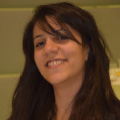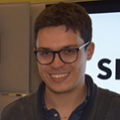

Lo SPIE Student Chapter dell’Università di Trento è stato fondato nell’ottobre 2016 da un gruppo di dottorandi, supportati dal direttore del Dipartimento di Fisica, il professor Lorenzo Pavesi.
Si tratta della sezione studentesca locale (Chapter) dell’associazione internazionale no-profit SPIE (International Society for Optics and Photonics), che si propone di connettere e sostenere studenti e ricercatori che lavorano nel settore dell’ottica e della fotonica. A partire dalla sua fondazione, l’associazione ha organizzato numerosi eventi, sia di carattere divulgativo che di carattere più accademico. Attualmente i componenti del Chapter sono 22 e formano una forte comunità composta da giovani ricercatori dell’Università di Trento e della Fondazione Bruno Kessler (FBK).
Per festeggiare il primo anno di attività è stato organizzato il workshop "Photonics as a Key Enabling Technology" che aveva lo scopo di far dialogare i diversi ambiti in cui la fotonica è ritenuta una tecnologia fondamentale per la crescita e l'occupazione.
L’evento ha visto la partecipazione di cinquanta persone, con nove speaker fra i quali la professoressa Andrea Armani della University of Southern California e altri relatori dell’Università di Trento e della FBK. La professoressa Armani ha realizzato due presentazioni. La prima era legata ad una tematica scientifica, dal titolo “Developing nanotechnology to study biological systems”, in cui ha mostrato come nel suo gruppo sia stato sintetizzato e caratterizzato un materiale polimerico sensibile alle radiazioni ultraviolette, che si rompe in maniera irreversibile una volta esposto alla radiazione. Questo comportamento è selettivo nei confronti della radiazione UV, e dimostra una risposta minima alla radiazione visibile e infrarossa. Inoltre, a seguito della rottura, il polimero cambia colore. Integrando questo polimero in una struttura a tre livelli, il gruppo di ricerca di Armani ha dimostrato la possibilità realizzare un dispositivo flessibile in grado di indicare l’esposizione alle radiazioni UV, con applicazioni estremamente interessanti nel mondo della prevenzione sanitaria. La seconda presentazione è stata invece dedicata allo sviluppo professionale, dal titolo “How to Prepare for an Academic Position”. Lo scopo del workshop è stato quello di realizzare un network fra ricercatori, cercando anche di far conoscere agli studenti che hanno preso parte all’evento quali sono attualmente le maggiori tematiche di ricerca portate avanti.
Si è affrontato il tema dei dispositivi fotonici integrati, che vengono studiati in collaborazione fra l’Università di Trento e FBK, così come dell’utilizzo di fotodiodi a valanga per realizzare detector al singolo fotone; si è discusso di come la fotonica possa contribuire nella realizzazione di biosensori, nonché dello studio del cervello mediante l’utilizzo di fluorescenza non lineare. La seconda parte della giornata è stata dedicata a una sessione poster, dove i dottorandi hanno avuto l’opportunità di mostrare i risultati delle loro ricerche e di discutere i propri risultati. Sono stati premiati i migliori tre poster.
Per l’associazione il 2017 si è dimostrato dunque un primo anno produttivo e ricco di successi e sono già in programma numerosi appuntamenti anche per il 2018. Il più importante è il 6th International Symposium on Optics and its Applications (OPTICS-2018), che si terrà a Trento dal17 al 20 febbraio. Lo scopo della conferenza è quello di mettere a contatto studenti, giovani e ricercatori più esperti che lavorano in nazioni diverse nell’ambito dell’ottica e della fotonica. L’organizzazione dell’evento è curata da 15 sezioni locali di SPIE e di OSA (The Optical Society) collegate a università ed enti di ricerca internazionali. Parteciperanno alla conferenza relatori provenienti da una decina di istituzioni di ricerca europee. Durante la conferenza si terrà anche una sezione speciale dedicata allo sviluppo professionale, con un confronto fra diversi punti di vista provenienti dall’ambito accademico e da quello industriale. Anche gli studenti avranno l’opportunità di presentare le loro attività di ricerca, con presentazioni orali e poster.
Il bando per presentare la propria candidatura è online: chi desidera proporsi per presentare la propria attività di ricerca durante la conferenza è il benvenuto.
A WORKSHOP WITH OPTICS AND PHOTONICS ENTHUSIASTS
The UniTrento Student Chapter of SPIE, the international society for optics and photonics
The SPIE Student Chapter of the University of Trento was established in October 2016 by a group of PhD students with the support of professor Lorenzo Pavesi, director of the Department of Physics.
SPIE (International Society for Optics and Photonics) is an international not-for-profit association which brings together students and researchers in the area of optics and photonics. Since its foundation, the 22 members of the chapter have organized many public and academic events, with the goal to create a strong community of young scientists from the University of Trento and Fondazione Bruno Kessler (FBK).
In celebration of its first anniversary, the Chapter has organized a workshop on "Photonics as a Key Enabling Technology", with the purpose to connect the different fields where photonics is a key enabling technology for growth and employment.
The workshop was attended by 50 people and 9 speakers were invited to give presentations, including professor Andrea Armani from the University of Southern California, and others from the University of Trento and FBK. In the first of her two talks, “Developing nanotechnology to study biological systems”, Professor Armani described how her research group was able to synthesize and characterize a UV-responsive polymeric material which irreversibly cleaves upon exposure to UV light. This photo responsive behavior is selective to UV wavelength, with minimal response to visible or near-IR wavelengths. Additionally, upon cleavage, the polymer changes color. By integrating the polymer into a tri-layer structure, the research group demonstrated that it is possible to create a flexible UV indicator strip that can be used in preventative healthcare. In her second lecture, “How to Prepare for an Academic Position”, Professor Armani changed the subject from science to professional development.
The workshop succeeded in providing a networking opportunity for the participating students and researchers but also in providing information on the most important research directions in optics and photonics. Other topics discussed at the workshop included integrated silicon photonics devices, which are the object of a research collaboration between UniTrento and FBK, and photonic glasses, in particular Single Photon Avalanche Diodes; other speakers explained the role and importance of photonics in biosensors and to study the brain with nonlinear fluorescence imaging. A poster session took place in the afternoon, where doctoral students had the opportunity to show their research work and present the results achieved. The three best posters received an award.
As this very productive and successful first year comes to an end, the Chapter is already at work to organize a number of events for 2018. The most important of these will be the 6th International Symposium on Optics and its Applications - OPTICS-2018, which will take place in Trento, Italy, from 17 to 20 February 2018. The symposium aims to bring together young students and more experienced researchers from different countries who work in the fields of optics and photonics, and speakers from 10 different European research institutions have been invited to give lectures. The event is jointly organized by 15 local chapters of SPIE and OSA (The Optical Society) from various European universities and research institutions. A dedicated part of the symposium will deal with professional development, offering different perspectives reflecting both the industrial and the academic world. Students will have a chance to present their research with oral presentations and a poster session.
The call for abstracts is open: everyone is invited to participate.




